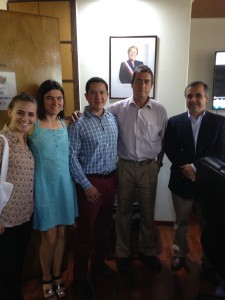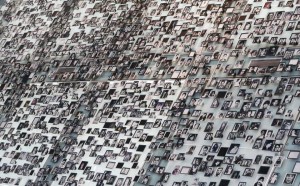- March 25, 2015
- 4:55 pm
- Mary Ann McGrath
- no comments
The Museum of Memories and Human Rights Strikes a Personal Chord
One of the students on our Chile study-abroad experience, Ismael Ruiz Hoyas, shares some very personal impressions and realizations related to our trip. The following is his dialogue:
Chile is a country that produces a wide range of commodities that include alpaca wool and limon de píca from Atacama; olive oil, papaya and pisco from Copiapo; pork, chicken, kiwi and Carménère wine from Central Valley; wood, milk products and beef in the South; and lamb wool in the Austral region. The most concerning problem farmers face is the lack of fresh water and the fact that the Atacama Desert, the driest desert in the world, grows 400 meters annually. On the bright side, 90% of the world’s population live in the northern hemisphere, so when winter comes in the northern hemisphere, Chile temporarily becomes the cornucopia that satisfies the world’s need for fresh produce.
Even though it was a lecture given by government representatives, our speaker Marcelo Muñoz, an Engineer Agronomist and fruit sector analyst, talked to us about their challenges in a very frank manner. He stated that labor work in the farming sector was the lowest paid in the country, which means high turnover and a scarce workforce. Some international clients have high sanitary demands and require farmers to measure their carbon and water footprint, another cost that diminishes the already low profit margin. This, plus the risk involved due to price volatility, is a hard sell to potential investors. The government provides some subsidies, but only to forestry in areas with erosion.
This lecture was especially interesting to me because I was raised around the farming industry. My father is also an Engineer Agronomist and I experienced firsthand the hard work it takes to be successful in this business.
After the lecture we had lunch and headed to the Museum of Memory and Human Rights. After checking in our bags, we were introduced to our guide and started the tour. Our guide spoke very softly and it was hard to hear him, so I drifted away from the group and chose to explore the museum on my own. On the morning of September 11, 1973, the military leadership issued demands to President Salvador Allende. A coup d’état against him was in process. I heard parts of the original Chilean radio broadcast of the events that day. I read letters from prisoners to their families, notes written by men that knew their fate was death but wanted to contribute something to document the awful things they witnessed inside those walls. I learned that up to forty thousand people were tortured, executed and/or desaparecidos (disappeared). Some of these folks managed to survive. The video of these survivors telling their stories and what they experienced made the hair on the back of my neck stand up. I felt guilty for not knowing more about this part of Chile’s history.
On the second floor, there was a glass balcony illuminated by electric candles. From this viewpoint I could see a huge wall with pictures of the people who disappeared or were executed. Many of the photos were passport pictures, but others had people posing, with their pets, smoking a cigarette, or fishing.
At this precise moment, I realized that all these people looked like MY family, friends and colleagues. Then I really started to feel the weight of what happened.
Our next class session in the U.S. featured the movie “NO!”, which detailed some of these events. History tends to be written by the victors. In my opinion, the right side won.
– Ismael Ruiz Hoyos

